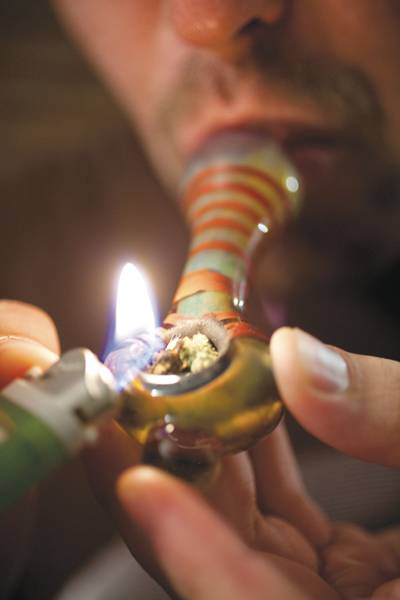Heckle: The road to legalization: Cannabis after WWII

A resident lights a bowl of marijuanna in one of the residence halls. Pot is the most commonly used illegal drug that people are cited for in residence halls. Photo: Rashah McChesney/Iowa State Daily
February 7, 2016
Though the attitudes of the American public have changed drastically on the issue of marijuana over the last 10 years, it is not the first time opinions have changed when it comes to the perception of pot. After the Marijuana Tax Act of 1937, cannabis maintained a false persona of violence and criminal activity in the eye of the public and government for almost 30 years. However, even in the years after Marijuana’s prohibition, the truth about cannabis was slowly being revealed.
In a study conducted in 1944, New York Mayor Fiorello LaGuardia and the New York Academy of Medicine found that marijuana was only “mildly intoxicating.” This report stood in direct contradiction with Harry Anslinger’s – head of the U.S. Treasury Department’s Narcotics Bureau – previous claims about the plant. Anslinger, along with members of the American Journal of Psychiatry, would then go on to publish a preemptive report against the LaGuardia’s study shortly before its release. Though Anslinger’s report addressed some issues about the nature of the study, specifically its observations of the prison population, it failed to combat LaGuardia’s claims about the nature of the substance itself.
This wouldn’t be the last time Anslinger’s racist, anti-marijuana attitudes would hide scientific truth about the plant from Americans. Fourteen years after LaGuardia’s study, the head of the Narcotics Bureau would attempt to prevent the publication of a joint study conducted by the American Bar Association and the American Medical Association. The study argued that penalties for marijuana possession were too harsh — an argument commonly found in today’s discussion of cannabis — and one that would be present during Nixon-era politics. Anslinger’s lobbying was successful in his attempts to kill the study as sponsors began to drop funding, but the study was later published by Indiana University Press.
Oddly enough, one of the main proponents of cannabis in the 1940s was the U.S. Federal Government. In 1942, the propaganda film “Hemp for Victory” was released in an attempt to encourage farmers to grow the plant for the war effort. The best argument for cannabis legalization was its many industrial uses but was exploited by the American government at the same time as the Treasury Department’s crusade against it. The film was a massive political success and in 1943, more than 375,000 acres of cannabis were grown by American farmers.
However, during the rise of the hippie era in the 1960s, even Anslinger would change his perspectives as a new demographic of young people began using cannabis — college students. While no one can determine the exact cause of this shift in user demographic, many attribute it to the free-spirited, anti-authoritarian attitudes of the hippie culture. The non-violent, peace enthused nature of these users came as a culture shock to the American people. Marijuana, formerly considered a dangerous, violent drug, began to show its true nature.
The laxed attitude toward marijuana and the realization of blatant lies told by the government created a wave of confusion even in major media outlets of the day. Major publications such as “Life,” “Newsweek” and “Look Magazine” even went so far as to question its illegality all together.
The racial attitudes so vital to the illegality of cannabis began to fall apart in the 1960s as well. As the demographic of users moved from poorer Mexican and African-American communities to mainly white college students. Anslinger himself would soften on the issue of marijuana as well, conceding that penalties for possession of marijuana among youth were too sever — a claim he had vehemently argued against just 15 years earlier. Yet, despite the changing attitudes, the amount of marijuana arrests at a state level would sky rocket between 1965 and 1970.
The newly found perspective of cannabis in America was short lived, however. As Nixon’s Republican Party took office in the 1970s, cannabis would once again find itself in the crosshairs of government regulation. By encouraging a media-led witch hunt on cannabis, Nixon was able to recreate the attitudes felt by Americans in the 1930s without much of the racial overtone. However, Nixon himself would be reminiscent of Anslinger, at least in their denial of facts.
In 1972, Nixon ordered the Commission on Marijuana and Drug Abuse led by Robert Shafer to study the criminal penalties for marijuana, hoping to gain support for his newly expanded drug laws. However, the Shafer Commission backfired as it recommended that the “possession of marijuana for personal use no longer be an offense, [and that the] casual distribution of small amounts of marihuana for no remuneration, or insignificant remuneration, no longer be an offense.”
Yet, Nixon did not repeal his expansive drug laws, nor did he argue for the legalization of marijuana. Instead, Nixon pressured Shafer himself to condemn the study’s findings and refused to receive the report in public.
The ebb and flow of public opinion toward marijuana would continue through the 20th century. Through the continual spread of misinformation and the denial of scientific fact, marijuana would remain illegal throughout the U.S. until 2014.
















